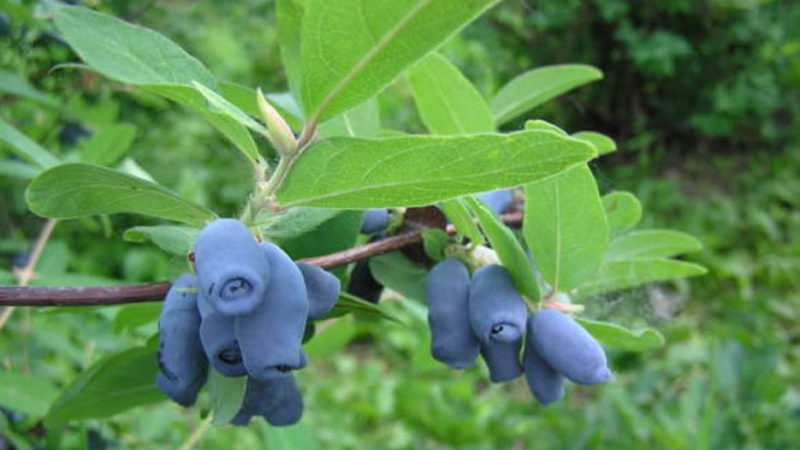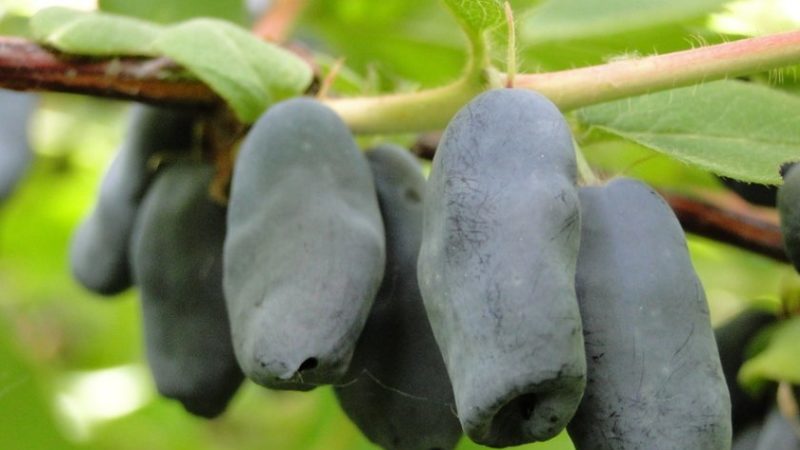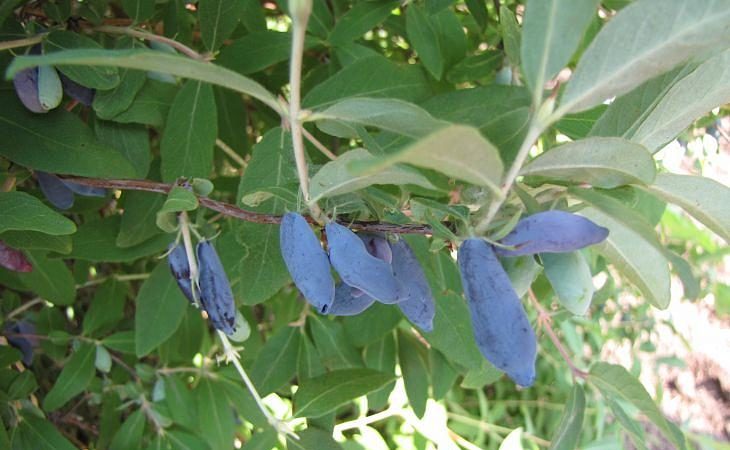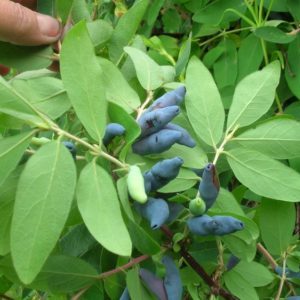Early maturing resistant variety of Vasyugan honeysuckle
Vasyugan is one of the most popular varieties of edible honeysuckle. It is unpretentious, characterized by a decorative type of bushes, frost resistance, early ripening and large-fruited. About what conditions are necessary for the development and fruiting of this honeysuckle, we will discuss further.
The content of the article
Description of the Vasyugan honeysuckle variety
Vasyugan is a variety of edible honeysuckle, bred by domestic breeders.
It is resistant to frost and pests and has a pleasant, sweet and sour taste of berries, 100 g of which contains 58 mg of ascorbic acid, 5.7% of monosaccharides, 2.7% of organic acids.
Breeding history

The variety was bred in the Bakcharsky stronghold of northern horticulture of the Research Institute of Horticulture of Siberia. M. A. Lisavenko as a result of free pollination of the elite form No. 68/2 of Turchaninov's honeysuckle. The authors of Vasyuganskaya are I.K. Gidzyuk and A.T. Tkacheva.
The variety is included in the State Register of Russia in 1990, the originator is Federal State Budgetary Scientific Institution "Federal Altai Scientific Center of Agrobiotechnology".
Reference. The variety is named after r. Vasyugan, flowing in the southwest of Siberia.
Characteristics, description of appearance, taste
The plant is a medium-sized shrub, reaching a height of 1 m, with a medium spreading crown of a rounded shape and slobopus, thin and flexible shoots of a reddish-green color. Leaves are green, medium-sized, pubescent, broadly lanceolate with an elongated apex.
During flowering, which occurs in early May, small, pale yellow flowers with long stamens and a slight aroma are formed at the tops of the shoots, collected in inflorescences of 3-5 pcs.
The berries are large, elongated, pitcher-shaped with a flat top, reaching a length of 2.2 cm and weighing an average of 0.8-1.2 g. They are covered with a thin, slightly bumpy skin of a dark purple, almost black color with a thin layer of waxy coating.
The pulp is firm, has a sweet taste with a slight sourness, without bitterness.

Application
The berries of Vasyugan honeysuckle are characterized by universal application. They are eaten fresh, frozen, dried or preserved.
The bushes of this variety have a decorative appearance, so they are often used to decorate the site.
Ripening period, yield and fruiting
This is an early ripening variety - the berries begin to ripen in early June.
Fruiting begins in the second year after planting. Average yield - 85 kg / ha.
Reference. The maximum yield of Vasyugan honeysuckle is 116 c / ha.
Disease and pest resistance
The variety is resistant to diseases, but in conditions of high humidity and with improper care there is a risk of damage by powdery mildew, various forms of spotting, soot fungus, potato virus and cucumber mosaic.
Among pests, aphids, scale insects, honeysuckle fingerflies and rootworm nematodes are dangerous.
Cold and drought resistant
Vasyugan can withstand frosts down to –40 ° C and withstands a short drought.
Growing regions and climate requirements
The variety prefers a temperate climate, but with proper care it grows and develops in all regions.
Advantages and disadvantages of the variety

Variety advantages:
- early maturation;
- excellent taste without bitterness;
- frost and drought resistance;
- high immunity to diseases;
- good keeping quality and transportability;
- rapid growth during the first years after planting.
Cons of Vasyugan:
- uneven ripening of the crop;
- shedding of fruits after full ripening;
- the need for pollinating plants.
Difference from other varieties and hybrids
Comparison of Vasyugan with other early maturing varieties of honeysuckle is presented in the table.
| Variety | Average weight of berries, g | Taste | Berry shape | Productivity, c / ha |
| Vasyugan | 0,8-1,2 | Sweet with sourness | Elongated, pitcher-shaped, with a flat top | 85 |
| Cinderella | 1-1,4 | Sweet with sourness | Oval-elongated, elongated or fusiform | 10,5 |
| Kamchadalka | 0,8 | Sweet and sour | Elongated | 31 |
| Baikal | 1 | Sweet | Oblong | 66,6 |
Agrotechnics
Compliance with the agrotechnical requirements of the culture is a prerequisite for the annual receipt of a full harvest.
Choosing a place in the garden and preparing holes
For planting Vasyugan honeysuckle, they choose an illuminated place located on a hill and protected from gusty winds and drafts.
Reference. Shading negatively affects the development and fruiting of bushes.
The plant does not tolerate excessive moisture, therefore, when choosing a place for planting, make sure that there are no swamps or other bodies of water nearby, and the groundwater level is at least 1 m.
Preparation of seedlings
For planting, choose healthy seedlings with flexible, intact roots and strong shoots. Before planting, the roots are placed in a growth stimulant solution ("Kornevin", "Epin") for 2-3 hours.
The land on the site is dug up in advance and cleaned of plant residues. Sandy soil is enriched with manure and peat, chalk, lime mortar or dolomite flour are introduced into the soil with high acidity.
Ground requirements
The variety prefers fertile, loose soil with aeration, moisture permeability and neutral acidity. The best option is loam or sandstone.
Timing, scheme and landing rules
Planting dates depend on the climatic conditions of the region: in the northern strip, characterized by early frosts, spring planting is preferable (late March - early April), in the southern regions - autumn (late September - early October).
Landing order:
- Dig out 40 × 40 cm planting holes in the selected area.
- Add compost, superphosphate and ash to each nutrient mixture.
- Place the seedlings in the grooves, spread the roots, sprinkle with soil mixture so that they are 5-7 cm deep.
- Lightly tamp the ground, pour warm water and mulch.
The distance between the bushes should be 1.8-2 m, between the rows - at least 2.5 m.
Growing features
Water the plants under the root as the top layer of the soil dries, on average 2-3 times a month.
The earth around the bushes is not loosened, and weeding is carried out as carefully as possible so as not to damage the root system located close to the surface.
They begin to feed honeysuckle from the second year after planting seedlings. In early spring, organic fertilizers are applied (manure, peat, silt, compost), and during flowering and fruit formation, the bushes are watered with an ash solution (1 liter of ash per bucket of warm water).
During the first 3-5 years, only dry, damaged branches and unnecessary shoots and root shoots are cut off, which give the bushes an ugly shape. When the plants are 8-10 years old and fruiting decreases, the crown is thinned out and the upper shoots are partially cut off.
Important! You cannot cut off the tops of the bushes - fruits are formed on them.
Pollinators
Vasyugan is a self-infertile variety, therefore, other varieties of honeysuckle are planted nearby to form ovaries and fruiting. Top pollinators:
- Blue spindle;
- Blue bird;
- Tomichka;
- Cinderella;
- Kamchadalka;
- Malvina;
- Moraine;
- In memory of Kuminov;
- Daughter of the Giant.
Disease and pest control
Possible diseases and pests of the variety are presented in the table.
| Disease / pest | Signs | Treatment |
| Powdery mildew | The leaves are covered with a white bloom, gradually dry out, crumble. | The affected foliage is removed. The bushes and the ground near them are treated with a solution of potassium permanganate and the preparations "Vitarol", "Previkur" or "Skor". |
| Spotting | Brown or yellowish spots of various sizes appear on the leaf plates, the leaves dry out and fall off, the young tops and shoots die off. | The affected branches are removed and burned. Plants are treated with "Fitolavin" or "Rapsol". |
| Sooty fungus | First, dark spots appear on the leaves, then the entire leaf plate turns black. | The bushes are sprayed with Bordeaux liquid and treated with antifungal drugs: "Fitover", "Fundazol", "Topaz". |
| Potato virus | The leaves are covered with light green spots. | There is no cure. The affected bushes are dug up and burned. |
| Cucumber mosaic | ||
| Aphid | Insects feed on sap from leaves and shoots; as a result, the plants weaken, wither. | The bushes are treated with "Inta-Vir", urea or potassium permanganate, tobacco or ash solution.
For prophylaxis, in the spring and autumn, they are treated with Lepidocid, Confidor or Bitoxibacillin. |
| Shields | The bushes dry out slowly and die. | |
| Honeysuckle fingerflies | Pests destroy the pulp of berries and seeds. Unripe fruits wrinkle and crumble. | |
| Gall nematodes | Pests suck the juice from the roots, carry viruses, as a result, the plants weaken and die. | To minimize the risk of damage by these pests, plant roots are treated with 0.2% Topsin-M solution and the ground around the bushes is disinfected. |
During the flowering and fruiting period, it is impossible to treat the bushes with pesticides.
Preparing for winter
Preparing honeysuckle for winter the soil is cleaned of fallen leaves and other debris, organic or potassium-phosphorus fertilizers are applied, dry and damaged shoots are cut from the bushes, and long branches are removed from the supports and bent to the ground. Plants are covered with spruce branches, a layer of mulch (hay or straw) or a special material - geotextile or lutrasil.
Reference. In regions with mild winters and frosts down to –15… –20 ° C, winter shelter is not required.
Reproduction
The best way to reproduce Vasyugan is to divide the bush... To do this, choose a strong plant at the age of 3-5 years, carefully dig it out and divide it into several parts without damaging the root system.
Some gardeners prefer to use the cuttings method. Developed vertical or horizontal processes are cut off from the plant and planted in a nutrient substrate. In this case, no more than half of the specimens take root.
Seed propagation is practically not used, despite good germination and rapid development of seedlings, since in this case the plants lose their parental genes, and the bushes grown from seeds do not bear fruit.
Growing difficulties
When cultivating this variety, some problems may arise:
- low yield, small berries - the bushes do not receive enough light due to the fact that they grow in the shade or are too dense;
- a white bloom appeared on the leaves - probably a sign of powdery mildew, which develops when growing bushes in acidic soil;
- peeling of the bark 3-5 years after planting is a characteristic feature of the variety.
Harvesting
The first berries begin to ripen in early June, mass ripeness occurs in the middle of the month. The crop is harvested by hand in 2-3 stages as the fruits ripen.
Advice and feedback from experienced gardeners
Experienced gardeners recommend:
- do not plant bushes in the shade, otherwise the yield will decrease, and the berries will be small;
- avoid loosening or carry out it carefully so as not to damage the roots.
Gardeners speak positively about the variety.
Victoria, Taganrog: “I chose this variety on the advice of a shop assistant and she praised it a lot. I didn't know anything about the need for pollination, but I was lucky that several honeysuckle bushes were already growing on the site. As a result, I am satisfied with the variety - it bears fruit every year, the berries are large and tasty. "
Inga, Krasnodar: “I planted Vasyuganskaya 10 years ago, I was afraid that the seedlings would not take root because of the heat, but the variety turned out to be hardy. The bushes have grown, now they decorate the site, there are a lot of berries, there is enough to eat fresh, and for seaming - I make jam and compotes out of them. "
Conclusion
Vasyugan honeysuckle is a light-loving and frost-resistant crop that pleases gardeners with a rich harvest of tasty and healthy berries. The variety is immune to diseases, is not picky about care and, subject to the rules of agricultural technology, grows and bears fruit in one place for more than 20 years.